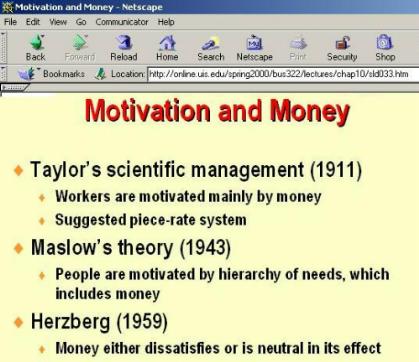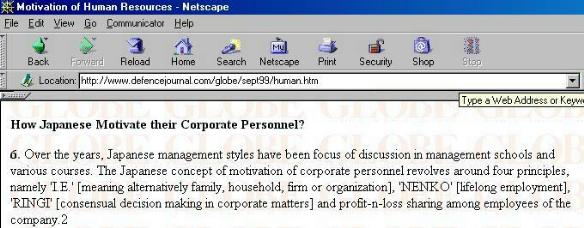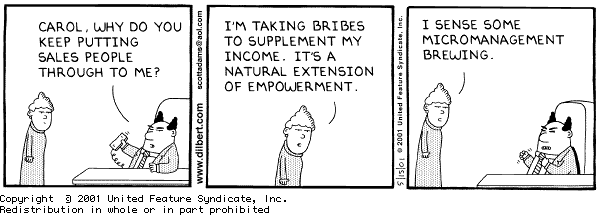 |
BUS 203
Business & Human Resources |
|
|
||
|
||
|
|
Chpt 16
 |
The Importance of Employee Motivation Performance =
page 441 text |
Chpt 16
 |
Is it possible to really be effective at motivating people? If so, how do you do it?
|

Chpt 16

Chpt 16
|
Historical Perspectives on Motivation Taylor page 441
"assumed that economic gain was everyone's primary motivation" (which may have been true in the factors of Northern England in the late 1800's)
|
Chpt 16
 |
Individual Human Needs
|
Chpt 16
 |
Equity Theory text page 452 "... people are motivated to seek social equity in the rewards they receive for performance translation ! people want to get paid fairly for working for the same amount as others who have the same level of experience and skill. |
Chpt 16
 |
Reinforcement Perspectives on Motivation text page 453 - 454 "... behaviour that results in rewarding consequences is likely to be repeated".
|
Chpt
16
 |
Emerging Perspectives on Motivation text page 454 The Japanese Approach "... bringing managers and workers together as partners"

The Japanese concept of motivation of corporate personnel revolves around four principles 1. family is the firm"Company employees (and their representatives, the unions) have a strong interest in the survival and growth of their company, and agree in principle with the managers on such matters as distribution of profits, levels of output, and employment." http://web.iss.u-tokyo.ac.jp/newslet/SSJ2/nitta.html |
Chpt 16
 |
Using Reward Systems to Motivate Performance text page 457 Reward System:
Designing Effective Reward
Systems text page 458
|
Chpt 16
 |
Empowerment text page 457
Empowerment is mentioned
briefly in the text on the bottom of page 457 - but it deserves to have
more discussion.
"In today's organisations, increasing attention is being given to employee empowerment. Empowerment is the process of giving people more scope or 'power' to exercise control over, and take responsibility for, their work. The responsibility for decision-making is pushed down the hierarchy so that those who do the task make the decisions about the task." and "Empowerment exists in an organisation when lower level employees feel that they are expected to exercise initiative in good faith on behalf of the mission even if it goes outside the bounds of their normal responsibilities; and if their initiative should lead to a mistake - even a serious one - they trust that they will not be arbitrarily penalized for having taken that initiative." from http://member.nifty.ne.jp/GCHE/HRM/Motivate/Chapter7.htm |

Chpt 16
 |
Merit System text page 459 reward is based on people's
job performance
Incentive System text page 459 reward is based on what they
actually do
|
Chpt 17
 |
|
Chpt 17
 |
Chapter 17 — Leadership and Influence
Processes
The textbook for BUS 203
has an online companion website - at which you can find all kinds of interesting
stuff.
|
Chpt 17
 |
Distinctions between Management and Leadership text page 469
|
Chpt 17
 |
Power text page 469-470  Power
! Power
!
|
Chpt 17
 |
Leadership Grid text page 475
The Leadership Grid® provides a framework for understanding types of leadership. The grid consists of two behavioral dimensions: 1.Concern for
production
"The Leadership Grid was developed over 30 years ago by two behavioral scientists, Drs.Blake and Mouton. It has been the most extensively used management and leadership development program, throughout the world. The Grid itself is the most reliable visual framework we know of for understanding various approaches to leadership." "While there are numerous
ways of looking at the relationship between Production and People concerns,
the Grid identifies seven major theories about how people exercise leadership
in the pursuit of organizational objectives with and through others, and
how each of the seven theories affects productivity. It allows people
to see the differences and similarities among them, to identify the strengths
and weaknesses of each style, and to develop conclusions regarding sound
and unsound ways of leading."
|